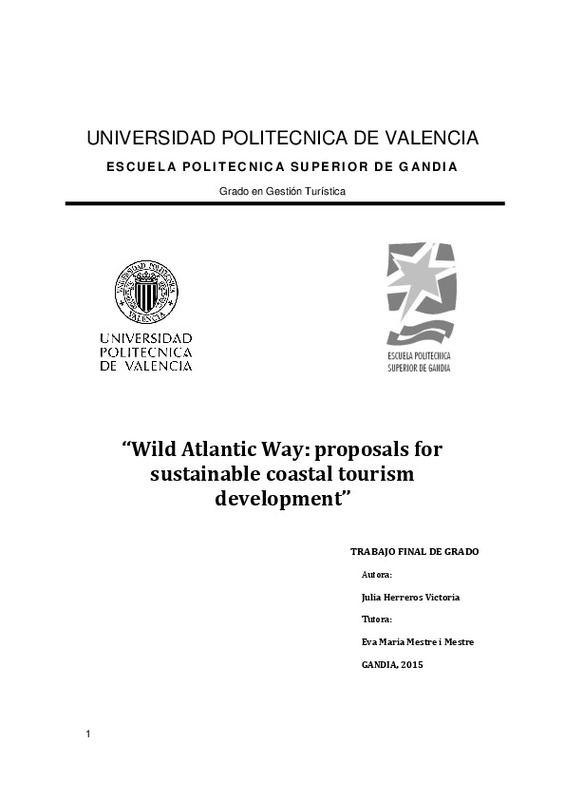JavaScript is disabled for your browser. Some features of this site may not work without it.
Buscar en RiuNet
Listar
Mi cuenta
Estadísticas
Ayuda RiuNet
Admin. UPV
Wild Atlantic way: proposals for sustainable coastal tourism development
Mostrar el registro sencillo del ítem
Ficheros en el ítem
| dc.contributor.advisor | Mestre i Mestre, Eva María
|
es_ES |
| dc.contributor.author | Herreros Victoria, Julia
|
es_ES |
| dc.date.accessioned | 2016-02-04T14:01:43Z | |
| dc.date.available | 2016-02-04T14:01:43Z | |
| dc.date.created | 2015-12-21 | |
| dc.date.issued | 2016-02-04 | es_ES |
| dc.identifier.uri | http://hdl.handle.net/10251/60639 | |
| dc.description.abstract | This Project is a study about the route named Wild Atlantic Way, the World’s longest coastal route, which runs along 2,500km on the West coast of the Republic of Ireland. It starts in County Donegal and ends in County, and runs along all the counties in the West side of the country: County Sligo, County Mayo, County Galway, County Clare and County Kerry. The main idea of this work is to develop a marketing plan to market and promote this coastal route for the Spanish market. In particular, the idea is to focus on a particular profile; cyclists, and see how this can increase Spanish tourism in Ireland and at the same time offer the Spanish tourist the opportunity to know and enjoy an offer for sustainable tourism development. Another idea pursued with this is the suggestion of some ideas to improve the development of the actual route, and the expansion of the Wild Atlantic Way route. This coastal route is a young project from "National Tourism Development Authority" known as "Fáilte Ireland", and there are some points that can be improved | es_ES |
| dc.description.abstract | Este proyecto en un estudio sobre la ruta conocida como Wild Atlantic Way, la mayor ruta costera del mundo, la cual abarca 2.500 km de la costa oeste de la República de Irlanda. Dicha ruta comienza en el condado de Donegal para finalizar en el condado de Cork, atravesando los condados del oeste: Sligo, Mayo, Galway Clare y Kerry. La idea principal de este trabajo es proponer un plan de marketing para exponer y promover esta ruta costera en el mercado español, centrándonos en un perfil determinado y ver de qué manera se puede aumentar el turismo español en Irlanda y al mismo tiempo ofrecer al turista español la oportunidad de disfrutar y conocer una oferta relacionada con el turismo sostenible y su desarrollo. Otra idea es sugerir algunas propuestas de mejora, para el desarrollo y el crecimiento de la ruta costera "Wild Atlantic Way". Esta ruta es un proyecto relativamente joven creado por la Autoridad Nacional de desarrollo turístico, también conocida como "Fáilte Ireland", por lo cual presenta algunas carencias, que se pueden mejorar | es_ES |
| dc.format.extent | 50 | es_ES |
| dc.language | Inglés | es_ES |
| dc.publisher | Universitat Politècnica de València | es_ES |
| dc.rights | Reserva de todos los derechos | es_ES |
| dc.subject | Active tourism | es_ES |
| dc.subject | Coastal development | es_ES |
| dc.subject | Sustainable tourism | es_ES |
| dc.subject | Desenvolupament costaner | es_ES |
| dc.subject | Turisme sostenible | es_ES |
| dc.subject | Ireland | es_ES |
| dc.subject | Cycle tourism | es_ES |
| dc.subject.classification | FILOLOGIA INGLESA | es_ES |
| dc.subject.other | Grado en Turismo-Grau en Turisme | es_ES |
| dc.title | Wild Atlantic way: proposals for sustainable coastal tourism development | es_ES |
| dc.type | Proyecto/Trabajo fin de carrera/grado | es_ES |
| dc.rights.accessRights | Abierto | es_ES |
| dc.contributor.affiliation | Universitat Politècnica de València. Departamento de Lingüística Aplicada - Departament de Lingüística Aplicada | es_ES |
| dc.contributor.affiliation | Universitat Politècnica de València. Escuela Politécnica Superior de Gandia - Escola Politècnica Superior de Gandia | es_ES |
| dc.description.bibliographicCitation | Herreros Victoria, J. (2015). Wild Atlantic way: proposals for sustainable coastal tourism development. Universitat Politècnica de València. http://hdl.handle.net/10251/60639 | es_ES |
| dc.description.accrualMethod | TFGM | es_ES |
| dc.relation.pasarela | TFGM\25065 | es_ES |
Este ítem aparece en la(s) siguiente(s) colección(ones)
-
EPSG - Trabajos académicos [5004]
Escuela Politécnica Superior de Gandia






